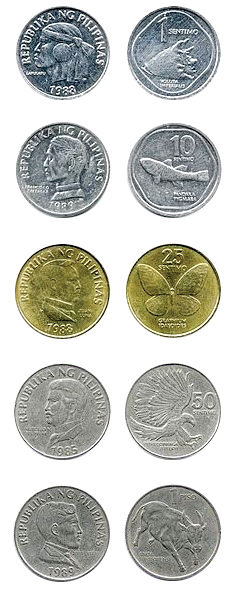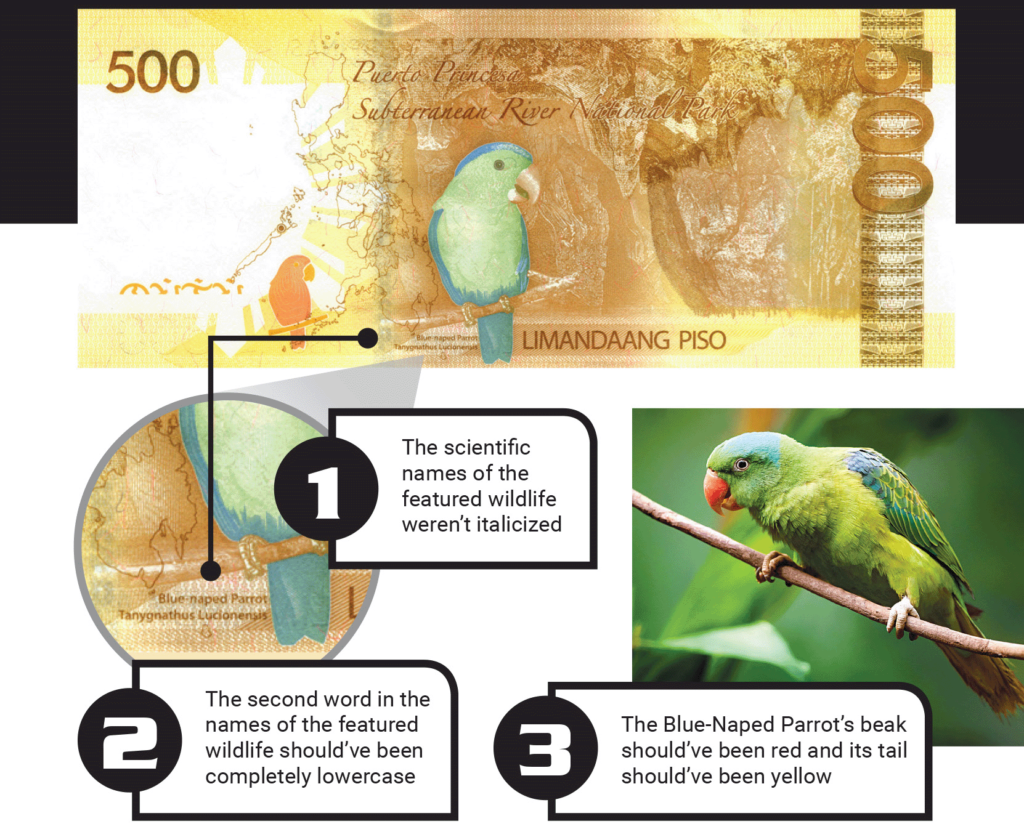The state of Philippine wildlife doesn’t tend to cross our minds on a daily basis, but it should. Our wallets are filled with Philippine Eagles (Pithecophaga jefferyi) and Blue-Naped Parrots (Tanygnathus lucionensis) — or at least pictures of them.
For decades, the obverse and reverse of Philippine currency have featured animals, even if only in the background. Here is a short history of animals on Philippine currency, from the 1940s to the present, based on information found on the Bangko Sentral ng Pilipinas website.

DEMONETIZED COINS AND BANKNOTES
When the Central Bank of the Philippines was created in 1949, the institution issued the English Series Banknotes, which were used until 1974. The obverse, or the front of the bills and coins, of the larger denominations featured portraits of Philippine heroes. The reverse, on the other hand, featured vignettes of Philippine history.
Of the banknotes from this series, only the half-peso notes that began circulating in 1955 featured an animal: the Carabao (Bubalus bubalis). The green banknote showcased Mt. Mayon and three men riding a Carabao-drawn cart on the obverse and its value on the reverse.
Once the English Series Banknotes were demonetized, the Central Bank began Filipinizing Philippine currency with the Pilipino Series (in circulation from 1969 to 1974) and the Ang Bagong Lipunan Series (in circulation from 1973 to 1993). Both banknote series featured designs similar to the English Series’ obverse and reverse, but with Filipino terms.
The difference between the Pilipino Series and the Ang Bagong Lipunan Series was largely based on the Ang Bagong Lipunan (The New Society) symbol published on the obverse of the latter, signifying the New Society reforms of the then president and dictator, Ferdinand Marcos, Sr. These Filipinized banknotes did not feature any animals, but the next series made up for their absence.
THE FLORA AND FAUNA SERIES

In 1983, the Central Bank launched the Flora and Fauna Series, coins ranging from 1 centavo to 2 pesos in denomination which would be in circulation until 1998. Each coin’s obverse featured a Filipino hero like Jose Rizal or Andres Bonifacio, while the reverse showcased rare fauna and flora indigenous to the Philippines.
The peso featured Jose Rizal on the obverse and the Tamaraw (Anoa mindorensis) on the reverse; the 50-centavo coin, Marcelo H. del Pilar and the Philippine Eagle; the 25-centavo coin, Juan Luna and the Philippine Butterfly (Graphium idaeoides); the 10-centavo coin, Francisco Baltasar and the Philippine Goby (Pandaka pygmaea); and the 1-centavo coin, Lapu-Lapu and the imperial volute Sea Snail (Voluta imperialis).
In 1991, the Central Bank had the aforementioned coins reduced in size and added a 5-peso coin (showing the Narra plant) to replace the 5-peso banknote, which was the most widely circulated denomination at the time.

CONTEMPORARY BILLS AND COINS
The timeline of Philippine banknotes in circulation includes many overlaps, including that of the Flora and Fauna Series and the New Design Series.
In 1985, the Central Bank began circulating the latter, which featured portraits of Philippine heroes and revolutionaries as well as more recent historical events such as EDSA II. Though the bills were modernized through the incorporation of security measures such as iridescent bands, the New Design Series banknotes were eventually demonetized in 2017 to give way to even more durable currency.
The New Generation Currency Series released in 2010 heralded a comeback for Philippine animals in currency since the Flora and Fauna Series, combined with portraits of influential Filipinos and vignettes of natural wonders across the country. On the obverse of the 1000-peso bill was Jose Abad Santos, Vicente Lim, and Josefa Llanes Escoda; the reverse featured the South Sea Pearl (Pinctada maxima) foregrounding the Tubbataha Reefs Natural Park in Sulu Sea. The 500-peso bill highlighted the Blue-Naped Parrot; the 200-peso bill, the Philippine Tarsier (Tarsius syrichta); the 100-peso bill, the Whale Shark (Rhincodon typus); the 50-peso bill, the Giant Trevally (Catanx ignobilis); and the 20-peso bill, the Palm Civet (Paradoxurus hermaphroditus philippinensis).

POLYMER AND THE PHILIPPINE EAGLE
Just last year, a 1000-peso polymer banknote was introduced for enhanced security and durability, but the change also came with a shift in design. Though the bill stayed blue and its reverse side still showcased the Tubbataha Reefs and the South Sea Pearl, the obverse was now the face of a Philippine Eagle with a Sampaguita flower by its side. For the first time in decades, a Philippine nonhuman animal was on the front of a bill.
The close-up shot of the Philippine Eagle is a stark contrast to the Carabao of the 1950s’ half-peso notes. In the words of the Bangko Sentral ng Pilipinas (BSP) as indicated on their website, the Philippine Eagle was meant to be the bill’s “focal point” to celebrate the country’s flora and fauna and exemplify “the Filipino’s uniqueness, strength, power, love for freedom, as well as a sharp vision for the country’s future.”
Perhaps the Philippine Eagle on the country’s first polymer bill is a hint of what’s to come: greater appreciation for nonhuman animals in the Philippines as we’re made to face their value every single day.
NEW GENERATION BANKNOTE BLUNDERS
According to a 2010 article written by Candice Montenegro for GMA News, scientists (and birders) had three main issues with the New Generation Currency Series:

The BSP explained that the color was a result of printing limitations, and errors could always be corrected in succeeding batches.






